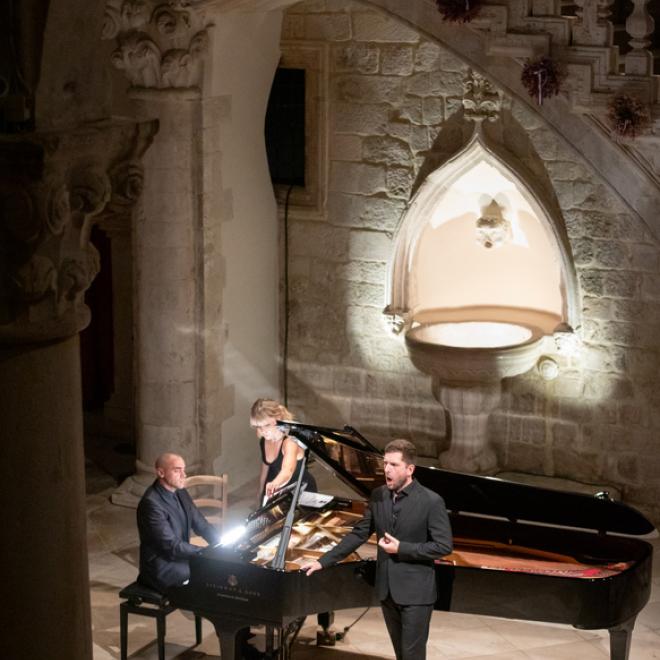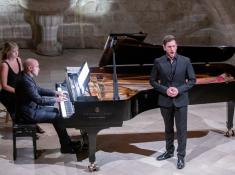
- More
- Performances
- Galleries
- Artists
Marko Mimica, bass-baritone
Marcos Madrigal, piano
PROGRAMME:
Hugo Wolf:
Michelangelo-Lieder
Wohl denk ich oft an mein vergangnes Leben
Alles endet, was entstehet
Fühlt meine Seele das ersehnte Licht
Maurice Ravel:
Don Quichotte à Dulcinée
Chanson romanesque
Chanson épique
Chanson à boire
Dmitri Shostakovich:
Preludes, Op. 34: Nos. 3, 15, 16, 17 and 24
Dmitri Shostakovich:
Polka (from The Golden Age)
Modest Petrovich Mussorgsky:
Songs and Dances of Death
Trepak
Lullaby
Serenade
Field Marshal
Croatia has a large number of world-renowned singers, most of all basses, and Marko Mimica is one of them. He will present himself and his powerful voice, his flawless bel canto technique and versatility at the Rector’s Palace. He will perform a programme created specifically for the Dubrovnik Summer Festival, consisting of lieder and arias.
MORE ABOUT THE PROGRAMME:
Notes by Dina Puhovski
Austrian-Slovenian composer Hugo Philipp Jakob Wolf (Slovenj Gradec, 1860 – Vienna, 1903) received his initial training in piano and violin from his father. He studied music theory at the Vienna Conservatory, from which he was expelled for disobedience. He continued composing and enjoyed the support of Wagner, Brahms and Mahler in his youth. Later he was often disappointed with the reception of his works and wrote only music reviews for some time, mostly for the Wiener Salonblatt. Eventually his works became increasingly appreciated, but his physical and mental health deteriorated, probably due to syphilis, and he died in a mental asylum at 42. The most significant part of Wolf’s output are Lieder, or art songs – the music form he brought to its highest point of development in the late romantic period. His early works include cycles of settings of poems by Goethe, Heine, Eichendorrf and Mörike. He set to music numerous other texts, including those collected in the Italienisches Liederbuch and the Spanisches Liederbuch. His three songs for bass voice on Sonnets of Michelangelo, translated by Walter Robert Tornow and published in 1897, were the last songs he wrote. The cycle is marked by his so-called late, ascetic style and simple structure, enabling the focus on the content and mental states of the narrator, often filled with gloom, as indicated by the titles ‘I often recall my past life’, ‘All must end that has beginning’ and ‘Does my soul feel the longed-for light of God who created it?’
The three songs that Don Quixote sings to Dulcinea in the collection Don Quichotte à Dulcinée from 1932 are the last completed work of Maurice Ravel (Ciboure, 1875 – Paris, 1937). Commissioned by the director G. W. Pabst, they were written for the film version of Don Quixote featuring Feodor Chaliapin: Pabst eventually used Jacques Ibert’s music instead of Ravel’s because he was not able to finish it in time due to illness. Premiered by the baritone Martial Singher and conductor and pianist Paul Paray in 1934, the songs were composed to the text of the novelist Paul Morand and orchestrated by Ravel. They were written in a simple, late style, but contain many Spanish folk elements. The first song, Chanson romanesque, is a warm serenade to Dulcinea; in Chanson épique the knight is praying to Virgin Mary and St Michael, with archaic-sounding accompaniment that reflects the Basque zortzico dance (Ravel’s mother was a Basque who lived in Madrid, and his father Swiss, which is why Stravinsky called Ravel ‘the most perfect of Swiss watchmakers’). The third is a cheerful drinking song: the striking coloraturas of the tipsy Don Quixote and the Aragon jota dance are the main elements of the final Chanson à boire.
Dmitri Shostakovich (Saint Petersburg, 1906 – Moscow, 1975) began his studies in piano and composition in his hometown at the age of thirteen. In addition to his success as a pianist, he had a fruitful career as a composer, marked by political pressure: His opera Lady Macbeth of Mtsensk was exceptionally popular until, after numerous performances, it was criticised in Pravda (1936), after which the composer withdrew his Symphony No. 4 on which he was working at the time, and wrote a sober, ‘reconciliatory’ Symphony No. 5, which restored his political status. At that time he taught at the Leningrad and then Moscow Conservatory, won numerous awards and composed successful pieces filled with drama and irony, but his music was once again deemed politically unsuitable in 1948. He lost his post at the Conservatory and turned to performing, recording and composing shorter forms. After Stalin’s death, he became a prominent Soviet composer. Shostakovich wrote fifteen symphonies, operas, ballets, concertos, sonatas, numerous film scores, string quartets, piano trios etc. He developed his own combination of styles, partially because he was forced to write ‘ambiguous’ music to avoid problems with the government, often using irony and ‘coding’ his original intentions. He wrote the ballet The Golden Age in 1929/30, naming it after the cabaret in which Boris, a young fisherman, falls in love with a dancer named Rita. The Polka movement is a typical example of playfulness of Shostakovich’s stage music. Like many composers before him, Shostakovich wrote piano preludes, which became Op. 34 in 1933 and which he premiered himself. They are basically ‘character movements’, and this evening’s selection includes the Lullaby from Prelude No. 3, the Spanish Dance from No. 15, the Little March from No. 16, the Memory of Chopin from No. 17 and the somewhat grotesque Funeral Gavotte from Prelude No. 24.
Modest Petrovich Mussorgsky (Karevo, 1839 – Saint Petersburg, 1881) was a Russian composer and a member of The Mighty Five, a group of five composers who attempted to create a distinct Russian national style of classical music (Borodin, Cui, Rimsky-Korsakov and Balakirev). His most famous works include the opera Boris Godunov and the cycle Pictures at an Exhibition (Maurice Ravel orchestrated what is probably the best known version of the cycle) and numerous art songs. He received musical training from an early age and spent a couple of years in the military service, where one of his fellow soldiers introduced him to the music of Mikhail Glinka, which inspired him to start thinking about the Russian style of classical music. He received his first lessons in composition at eighteen from Mily Balakirev; Mussorgsky was a close friend of the composer Rimsky-Korsakov, who finished his opera Khovanshchina and prepared many of his works for publication after his death. The final years of his life, as short Hugo Wolf’s, were marked by illness, loneliness, poverty and alcoholism. He masterfully channelled some of his misery into the cycles Sunless and Songs and Dances of Death, written to poems of Arseny Golenishchev-Kutuzov. His relatively small output turned out to be very influential, especially in the development of the Russian vocal style (in operas and 65 songs) and his innovative approach to harmony (although Rimsky-Korsakov minimised some of Mussorgsky’s innovations in his editions). Mussorgsky wrote Songs and Dances of Death from1874 to 1877. They consist of four ‘death’ ballads: the first three are about individual deaths, while the final deals with mass death in battle. Death dances with a drunken peasant, who freezes to death in the snow; she sings a sick child to eternal sleep; she circles around a girl with a fever and, like a general, it commands the battlefield. Death is at the same time a seductress and an all-powerful, victorious ruler, and sometimes it brings relief. With his harmonic solutions, restrained melodic development, powerful pedal tones, colour of the piano, different kinds of ‘stamping’ on piano etc., Mussorgsky sets new standards of musical portrayal of gloom, difficulties of life and inevitability of death.
- 28. July 2023./ Friday / 21:30 Rector's Palace Atrium +Tickets



